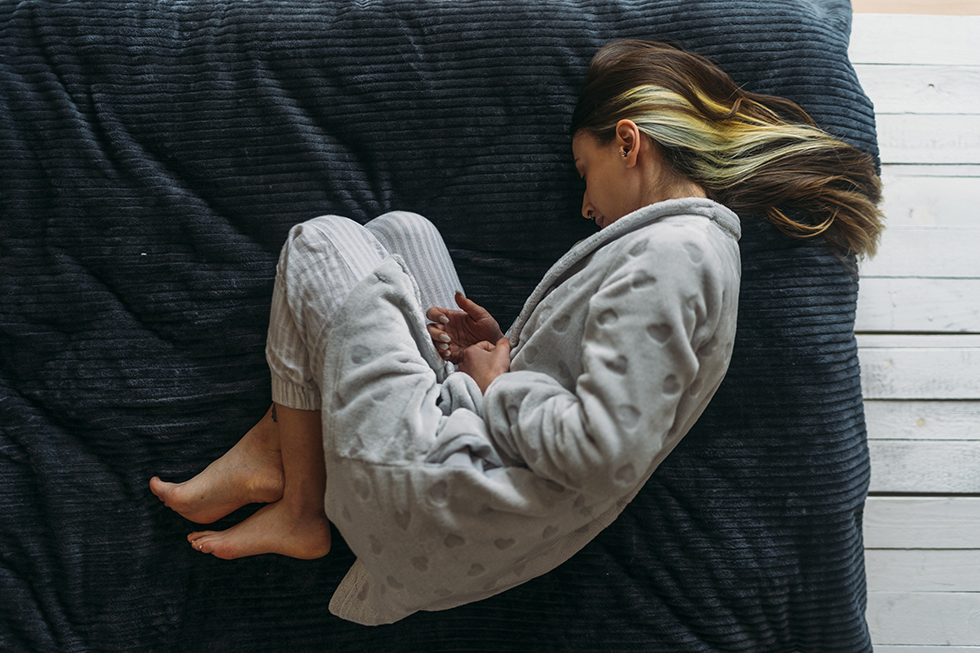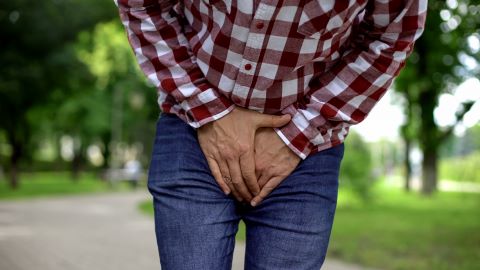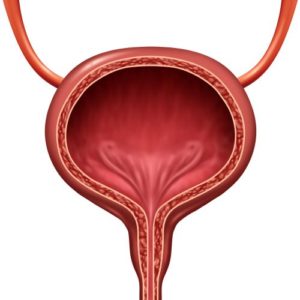Interstitial Cystitis/Bladder Pain Syndrome
What is Interstitial Cystitis?
Interstitial cystitis (IC) is sometimes called bladder pain syndrome in large part because a painful bladder is one of the most prominent symptoms. People with IC can also feel a frequent, urgent need to urinate. Some people feel mild discomfort, but others may have cases so severe that it disrupts their day-to-day lives.
IC can be a challenging condition because experts aren’t sure what causes it, and that makes it difficult to treat.

What Causes Interstitial Cystitis?
The exact cause of IC isn’t known, but scientists have some hypotheses. Some think IC is caused by abnormalities in the bladder lining. However, they’re not sure whether IC causes these abnormalities or if the abnormalities cause IC.
Other experts believe that nerves in the bladder itself and in areas outside the bladder (such as in the abdomen or pelvis) become more sensitive.
Scientists have also noted that, in some cases, IC develops after a urinary tract infection (UTI), vaginitis (inflammation of the vagina), or prostatitis (inflammation of the prostate). It might also start after surgery or trauma in the bladder/pelvic region.
IC can be a challenging condition because experts aren’t sure what causes it, and that makes it difficult to treat.
What are the Symptoms of Interstitial Cystitis?
The most common symptoms of IC are the following:
- Pain. Pain or discomfort may be located in or around the bladder, abdomen, or urethra (the tube that allows urine to exit the body). The pain may be mild or severe, and it could be occasional or constant. Pain might subside when you urinate.
- Frequent and urgent urination. Some people with IC need to urinate several times an hour. You might also feel like the need to urinate is more urgent.
For most people, IC symptoms come on gradually, becoming more intense over a period of months. However, symptoms can be severe from the start.
Symptoms can also get better or worse for a variety of reasons. For example, stress might aggravate symptoms. Or a spicy meal, coffee, or alcohol may cause greater discomfort. Some activities like having sex, exercising, or sitting for a long time could trigger symptoms. Women with IC may see symptoms flare during their menstrual periods.
IC can be especially challenging for people with other chronic pain conditions, such as irritable bowel syndrome (IBS), fibromyalgia, endometriosis, and prostatitis. Sometimes, IC symptoms flare when these other conditions flare.
Coping with IC can be difficult. It can affect daily life, relationships, and sleep patterns.
How is Interstitial Cystitis Diagnosed?
There is no definitive exam for diagnosing IC, and it can take time to rule out other conditions, like kidney stones or a bladder infection. IC can be diagnosed once a person has had symptoms for six weeks and other conditions that cause similar symptoms can be ruled out. But in general, the diagnostic process follows these steps:
IC can be diagnosed once a person has had symptoms for six weeks
Medical History
We’ll talk to you about your symptoms, their severity, their effects on your everyday life, your health history, your diet, and any medications you take. We’ll also ask you questions about urination, such as how often you have to urinate and how much urine you pass. You might be asked to fill out a questionnaire as well.
Some of these questions may sound intrusive or be somewhat embarrassing. But your complete, candid answers will help us tailor the right treatment plan for you.
Physical Exam
We’ll likely conduct pelvic and rectal exams, as gently as possible. Be sure to tell us if you’re experiencing any discomfort during these exams.
We might conduct a post-void residual urine test. This tells us how much urine stays in your bladder after you urinate. It can be done with a catheter or through an ultrasound.

You might also undergo neurological testing. The brain and the bladder work closely together, sending messages back and forth through your central nervous system. These messages may indicate that the bladder is full, that urine needs to be held, or that urine can be released. Through neurological testing, we can find out how well your brain, bladder, and nerves are communicating.
Other Urological Tests
We might conduct additional tests to rule out other health conditions. Here are some examples:
- A urine test. We’ll ask you to urinate into a special cup. Then, we’ll send your urine test to a lab for analysis.
- Cystoscopy. For this test, we use a special tool called a cystoscope to see inside your bladder.
- Urodynamic testing. Urodynamics refers to a group of tests that assess your bladder function. We’ll use a catheter to fill your bladder with water, and monitor how your bladder fills and empties.
Note: Cystoscopy and urodynamics tests are usually done in more complex situations. Not all IC patients undergo these tests.
How is Interstitial Cystitis Treated?
IC can be challenging to treat, as there is no single treatment that works for most patients. And it can take some time — sometimes even months — before symptoms start to improve. You might need to try several treatments before we find the one that works best for you. Some patients need a combination of treatments.
But we encourage you to stay positive. Most patients do get relief from their symptoms.
We’ll carefully consider the severity of your symptoms and your preferences for treatment as we develop a treatment plan. And pain management will be a priority. Generally, we start with conservative approaches, moving on to more complex approaches if necessary. We’ll be monitoring your response to treatments and your overall health as treatment continues.
Lifestyle Changes
As noted earlier, IC symptoms may flare in certain situations, like after you’ve eaten a certain food or when you’re feeling stressed. Taking some control over those situations might help your symptoms.
Diet
Certain foods and drinks can irritate the bladder, including the following:
- Citrus fruits (like oranges, lemons, and grapefruit)
- Tomatoes
- Chocolate
- Caffeinated drinks (like coffee, tea, and soda)
- Alcohol
- Spicy foods
To pinpoint specific IC triggers in your diet, we might have you follow an elimination diet for a while. With an elimination diet, you stop eating certain things to see if cutting that food or drink helps your symptoms. Then, one by one, you will add those foods back to your diet. If your symptoms worsen, we’ll know that food is a trigger for you.
Dietary triggers of IC vary from person to person. You may find that your symptoms flare after you eat tomatoes, for example, but a neighbor with IC may be able to eat all the tomatoes he wants without a problem. Or vice versa. What’s important is how certain foods affect you.
Stress
How effectively do you handle the stress in your life? Taking time to relax may help you manage IC symptoms. We know this is sometimes easier said than done, given busy schedules and important commitments. But even small “doses” of relaxation may provide some relief. Some people benefit from meditation, breathing exercises, spending time with friends, or working out at the gym. Asking for help is important, too. If you need support, talk to your family or friends. Counseling and support groups are other paths to consider.
Physical Therapy
We might refer you to a physical therapist who is specially trained to work with IC patients. Manual physical therapy can help release tightness in certain pelvic/abdominal muscles and connective tissues. (If such manipulation is painful, you can be given a local anesthetic.) You would likely attend physical therapy sessions once a week for 12 weeks or longer, and you might be assigned stretching exercises to do at home.
Note: Pelvic floor strengthening exercises, such as Kegel exercises, are not recommended for people with IC. Your physical therapist will make sure you know exactly which muscles to target during your sessions and home exercise program.
Prescription Drugs
While you’re making lifestyle changes, we might prescribe medications to help manage IC symptoms. Drugs may be administered orally (by mouth). Or we may use a catheter to place medications directly into your bladder. (This is called an intravesical approach.)
Oral Drugs
Some commonly used oral drugs include the following:
- Amitriptyline. This drug is an antidepressant, but it can also be used to treat chronic pain.
- Cimetidine. Typically prescribed to people with ulcers or gastroesophageal reflux disease (GERD), cimetidine may relieve nocturia (needing to urinate several times during the night) and pain.
- Hydroxyzine. Hydroxyzine is an antihistamine, a type of medicine used to treat allergies. Some experts think that IC pain is linked to increased amounts of histamine (a substance linked to allergic reactions) in the bladder.
- Pentosan polysulfate. This drug may relieve IC symptoms by restoring the bladder lining.
Intravesical Drugs
If we go this route, you might receive the following:
- Dimethyl sulfoxide (DMSO). DMSO is thought to reduce swelling, irritation, and pain in people with IC. Treatments with DMSO may be ongoing. An initial course might be given once a week for six weeks. Some patients continue to have DMSO treatments periodically as maintenance therapy.
- Heparin. This anti-inflammatory drug may relieve symptoms by soothing the bladder lining.
- Lidocaine. This drug is an anesthetic and may relieve pain.

Cystoscopy with Short-Duration, Low-Pressure Hydrodistension
As explained above, cystoscopy allows us to see inside your bladder by using a cystoscope. Cystoscopy helps us diagnose IC, but it can also be used in treatment.
During cystoscopy with short-duration, low-pressure hydrodistension we’ll add a special liquid that is designed to stretch your bladder to its maximum capacity. This stretching relieves symptoms for some patients, at least temporarily. (Note: You will receive anesthesia for this procedure.)
Botulinum Toxin A (Botox®)
During cystoscopy, small doses of botulinum toxin A (also known as Botox®) are injected into your bladder wall. This can relieve pain by relaxing your bladder muscle.
Botulinum toxin treatments are a short-term solution, however. You may need to repeat treatments every six to nine months.
Neurostimulation
Also called neuromodulation, this technique applies small, harmless electrical pulses to sacral nerves located near the sacrum, the lower portion of the spine, just above the tailbone (coccyx).
Typically, your brain sends signals to these nerves, which trigger the pain and urgency associated with IC. Neurostimulation stops these signals from reaching the nerves.
The process involves surgically implanting a small wire under your skin above your tailbone. You might notice the electrical pulse, but you shouldn’t feel pain. Most patients get used to the feeling in time.
Still, neurostimulation can have some drawbacks. If the wire needs to be adjusted or removed, there will be another surgery. Pain, infection, and bleeding are other possible complications.
Cyclosporine
If the treatments described above have not been helpful, we might prescribe an oral medication called cyclosporine. This drug needs to be used carefully. It is an immunosuppressant and could reduce the strength of your immune system. It also has a number of side effects, such as muscle or joint pain, cramps, headache, and diarrhea.
Surgery
In rare cases, patients may not have success with any other IC treatments. These patients may be candidates for surgery:
- Urinary diversion. A surgeon creates a new pathway for urine to flow out of your body. This approach might be combined with cystectomy — surgical removal of the bladder or part of the bladder.
- Augmentation/substitution cystoplasty. With this surgery, a portion of the bladder is removed and replaced with tissue from your bowel, thus increasing the size of the bladder.
What are Hunner’s Lesions?
About 5% to 10% of IC patients have Hunner’s lesions (sometimes called Hunner’s ulcers). These are small areas of inflammation that form on the bladder wall. They can be treated with the following techniques while you are under anesthesia:
- Fulguration. The surgeon uses a laser or electric current to remove the lesions off the bladder wall.
- Resection. The surgeon cuts the lesions off the bladder wall.
- Injection. The surgeon injects an anti-inflammatory drug called triamcinolone into the lesion.
Hunner’s lesions can usually be seen, and may be treated, during cystoscopy.
What Happens Next?
For some patients, IC symptoms go away after treatment. For others, treatment provides some relief, but flares still occur. We’ll still see you regularly for checkups. Be sure to let us know if symptoms start again or worsen.
You can lower the chances of IC returning or flaring by sticking with your treatment program, avoiding foods and drinks that irritate your bladder, and managing stress as best as you can.
Resources
American Family Physician
Dancel, Rex, MD, et al.
“Medications for Treatment of Interstitial Cystitis”
(January 2015)
https://www.aafp.org/afp/2015/0115/p116.html
Urological Association
Hanno, P.M., et al.
“Diagnosis and Treatment Interstitial Cystitis/Bladder Pain Syndrome (2014)”
(Published: 2011. Amended: 2014)
https://www.auanet.org/guidelines/guidelines/interstitial-cystitis-(ic/bps)-guideline
Drugs.com
Multum, Cerner
“Triamcinolone (injection)”
(Reviewed: March 5, 2021)
https://www.drugs.com/mtm/triamcinolone-injection.html
Healthline.com
Ghoshal, Malini, RPh, MS
“What You Need to Know About Triamcinolone”
(Reviewed: June 25, 2019)
https://www.healthline.com/health/triamcinolone
Interstitial Cystitis Association
“DMSO”
(Revised: July 6, 2015)
https://www.ichelp.org/diagnosis-treatment/treatments/bladder-instillations/dmso/
“Heparin”
(Revised: July 6, 2015)
https://www.ichelp.org/diagnosis-treatment/treatments/bladder-instillations/heparin/
“Hunner’s Ulcers”
(Revised: March 25, 2019)
https://www.ichelp.org/about-ic/symptoms-of-ic/hunners-ulcers/
“Surgical Procedures”
(Revised: March 25, 2015)
https://www.ichelp.org/diagnosis-treatment/treatments/surgical-procedures/
MedlinePlus.gov
"Cimetidine”
(Page last updated: September 29, 2021)
https://medlineplus.gov/druginfo/meds/a682256.html
“Cyclosporine”
(Page last updated: September 29, 2021)
https://medlineplus.gov/druginfo/meds/a601207.html
“Sacrum”
(Reviewed: May 13, 2019)
https://medlineplus.gov/ency/imagepages/19464.htm
UpToDate
Clemens, J. Quentin, MD, FACS, MSCI
“Patient education: Diagnosis of interstitial cystitis/bladder pain syndrome (Beyond the Basics)”
(Topic last updated: March 15, 2021)
https://www.uptodate.com/contents/diagnosis-of-interstitial-cystitis-bladder-pain-syndrome-beyond-the-basics
Clemens, J. Quentin, MD, FACS, MSCI
“Patient education: Treatment of interstitial cystitis/bladder pain syndrome (Beyond the Basics)”
(Topic last updated: December 10, 2019)
https://www.uptodate.com/contents/diagnosis-of-interstitial-cystitis-bladder-pain-syndrome-beyond-the-basics
Urology Care Foundation
Evans III, Robert J., MD, FACS
“7 Ways to Help Control Interstitial Cystitis Symptoms”
(November 28, 2016)
https://www.urologyhealth.org/healthy-living/care-blog/7-ways-to-help-control-interstitial-cystitis-symptoms
“Neurogenic Bladder: When Nerve Damage Causes Bladder Problems”
(November 27, 2019)
https://www.urologyhealth.org/healthy-living/care-blog/2019/neurogenic-bladder-when-nerve-damage-causes-bladder-problems
“What Are Some Options For Managing IC?”
(Fall 2019)
https://www.urologyhealth.org/healthy-living/urologyhealth-extra/magazine-archives/fall-2019/ask-the-experts-what-are-some-options-for-managing-ic
“What is Cystoscopy?”
https://www.urologyhealth.org/urology-a-z/c/cystoscopy
“What is IC/Bladder Pain Syndrome?”
https://www.urologyhealth.org/urology-a-z/i/interstitial-cystitis
“What is Urinary Diversion?”
https://www.urologyhealth.org/urology-a-z/u/urinary-diversion
“What is Urodynamics?”
https://www.urologyhealth.org/urology-a-z/u/urodynamics
WebMD
“Brain and Bladder Connection”
(Reviewed: April 30, 2018)
https://www.webmd.com/women/video/video-incontinence-brain-bladder
Women’s Health
Nordling, Jørgen
“Surgical Treatment of Painful Bladder Syndrome/Interstitial Cystitis”
(First published: March 1, 2006)
https://journals.sagepub.com/doi/full/10.2217/17455057.2.2.233
